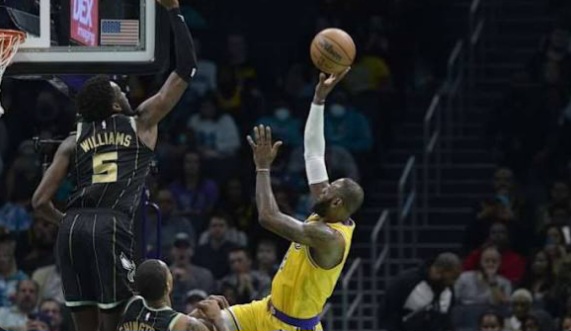It’s possible that the NBA world may have both over and understated the ramifications of the failed trade between the Charlotte Hornets and the Los Angeles Lakers.
The over-staters harped way too long about the impact it would have on both Mark Williams and Charlotte. To his credit, the veteran big man returned to the Queen City and operated as a consummate professional over the ensuing months. Williams played big minutes with the Hornets, never hung his head, and quickly put the awkwardness of the situation in the rear-view mirror.
Those on the other side of the aisle may have understated the impact the trade had on Los Angeles’ playoff rotation.
The Lakers moved on from the failed Mark Williams trade the second they saw Luka Dončic in purple and gold. Thoughts of the rescinded deal were quickly swept away by dreams of the Larry O’Brien trophy returning to Tinsel Town after LeBron James and Dončic took the NBA world by storm in their first few weeks as teammates.
JJ Redick found a formula that had the Lakers humming along in February when his Lakers had the league’s top defense and a devastating offense to boot.
However, as the scout on Los Angeles got out, cracks began to form in the Lakers’ strategy. And on Sunday evening in Minneapolis, those cracks burst down the stretch of their 116-113 loss to the Timberwolves.
The Lakers just don’t have enough good players in their rotation. For the first time in the NBA’s play-by-play era, Los Angeles played the same five players for the entire second half of a playoff game. Both Dončic and James were clearly hampered in the closing minutes as their energy reserves were depleted by Minnesota’s relentless two-way play.
Back to Williams.
Besides Los Angeles’ lack of playoff-caliber rotation players, their next biggest weakness is their lack of size. On defense, the Lakers don’t have a rim protector to mitigate their perimeter defensive deficiencies. LeBron James has operated like a Draymond Green-esque interior hub on defense, but Los Angeles needs his shot creation on offense too, and at 40-years-old, James can’t carry a team on both ends of the court like he once could.
The Timberwolves have attacked both Dončic and Austin Reaves incessantly on defense knowing that once they break through the Lakers’ first line of defense, there won’t be much resistance at the rim. While Mark Williams isn’t a dominant force when it comes to protecting the paint, his NBA Combine-record length standing reach would at least serve as a more potent rim detterent than James or Rui Hachimura.
On offense, things look fine for the Lakers, but they’re a one-trick pony. Due to their personnel, Los Angeles is forced to play a five-out style that can get swallowed up by Minnesota’s host of long-armed, Demagorgan-tempered defenders. Down the stretch of games the Lakers offense has devolved into Dončic-centric iso-ball, and although that isn’t the worst option in the world, having Williams as a rim-rolling option as an added wrinkle would open things up for the Lakers exponentially.
Luka thrived in Dallas when he played alongside Derrick Lively Jr. and Daniel Gafford – two screen-setting, rim-rolling, don’t-need-the-ball-in-their-hands bigs that created shots for their teammates with their big-bodied picks and hard dives to the cup. Williams could be that for the Lakers, giving them an extra pitch on offense when things get bogged down.
All of those things were valid concerns that were discussed when Rob Pelinka pulled the rug out from under Jeff Peterson, but they were hand-waved away when the Lakers ran through the league in February and march.
Now, with their season on the brink, Los Angeles is looking for answers anywhere they can find them, although the answer they once had is still employed in Charlotte ahead of the most pivotal offseason of his career.
Don’t let anyone tell you that the Hornets don’t matter, folks. They may have swung the race for the NBA championship by welcoming back Mark Williams to Charlotte.

